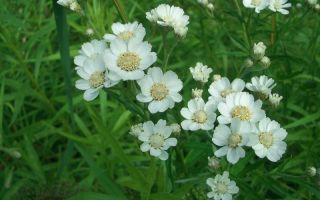Content
The medicinal properties of sneeze herbs and contraindications are of great interest to traditional medicine. The plant brings significant benefits in inflammatory and colds, and at the same time contains almost no harmful substances in the composition.
What it looks like and where it grows
Sneeze grass, common sneezer or yarrow ptarmica (Achillea ptarmica) is a perennial plant from the Astrov family with a creeping rhizome and a straight stem. It has solid narrow leaves with a serrated edge, glabrous or slightly pubescent. From June to September, it brings small white baskets of flowers, collected in shields. From July to mid-autumn, it bears fruit with flattened winged achenes with a pair of protruding ribs.

In its natural form, the common sneezer is widespread throughout Europe from Italy in the south to Norway in the north. You can meet it on the British Isles, in the Baltic States, and on the territory of Russia it grows in the central regions and in Western Siberia. Nowadays the sneezer has also naturalized in North America.
For development, the plant chooses well-moisturized places. You can see the sneezer on the banks of rivers and lakes, on swampy meadows, along the edges of forests.
Chemical composition
The common sneezer is of interest to traditional medicine due to the rich chemical composition of leaves, roots and flowers. The following components are present in parts of the plant:
- flavonoids and organic acids;
- vitamin C;
- alkaloids;
- tannins and tannins;
- cineole and eugenol;
- achilles;
- sexviterpenes;
- linalool and azulene;
- antioxidants.
In official pharmacology, the common sneezer is rarely used. But in the recipes of traditional medicine, it is found quite often and occupies important positions.
Medicinal properties of sneeze herb
An ordinary sneezer, when used correctly, has a positive effect on the human body. In particular, a medicinal plant:
- stops bleeding and promotes wound healing;
- has anti-inflammatory and analgesic properties;
- has an astringent effect;
- improves the outflow of bile and protects the liver from ailments;
- has an antiseptic effect and fights infections;
- relieves toothache and headache;
- reduces the temperature for colds and helps with a cold;
- improves kidney function;
- normalizes the condition with painful periods in women;
- stimulates the work of the gastrointestinal tract and improves the absorption of food;
- strengthens the immune system.
You can use an ordinary sneezer in both internal and external ways. It is used for lotions and compresses for wounds, scratches and abscesses.
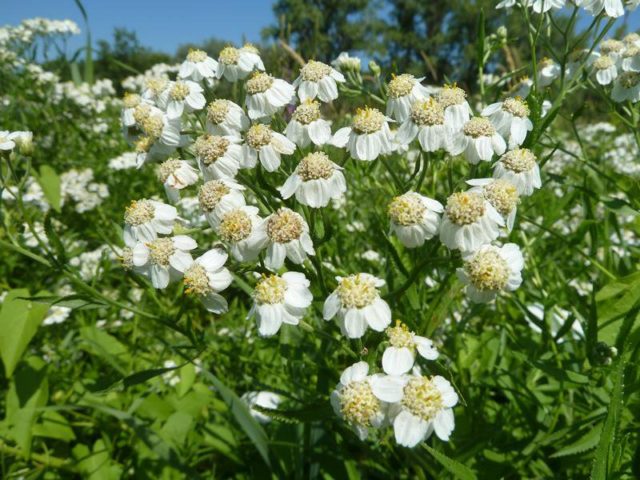
Preparation and application methods
Based on the leaves, stems and roots of the common sneezer, you can create several preparations for home use. Traditional medicine offers proven dosage algorithms.
Tincture
For colds, inflammatory processes and gum diseases, an alcoholic tincture of a sneezer has a good effect. The recipe for its preparation looks like this:
- 100 g of a dried plant is crushed and poured in 200 ml of vodka;
- clog the vessel and put it in a dark place for two weeks;
- after a lapse of time, pass the agent through gauze for filtration.
The resulting drug is taken in a dosage of 10-40 drops, depending on the disease, three times a day.
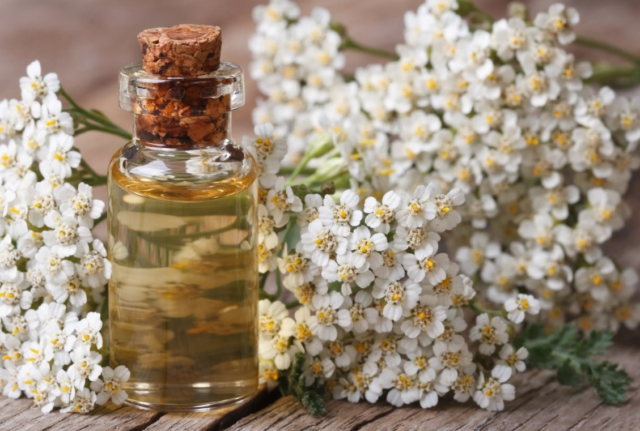
Infusion
An aqueous infusion of a common sneezer helps to improve the well-being in tuberculosis, and also reduces sugar levels and speeds up metabolic processes in the body. Prepare the drug as follows:
- dry leaves and flowers of the plant are crushed;
- measure out a small spoonful of raw materials and pour a glass of boiling water;
- cover the container with a lid and a towel and leave for two hours.
The finished infusion is filtered through folded gauze to remove the sediment. You need to take the remedy 30 ml on an empty stomach three times a day.
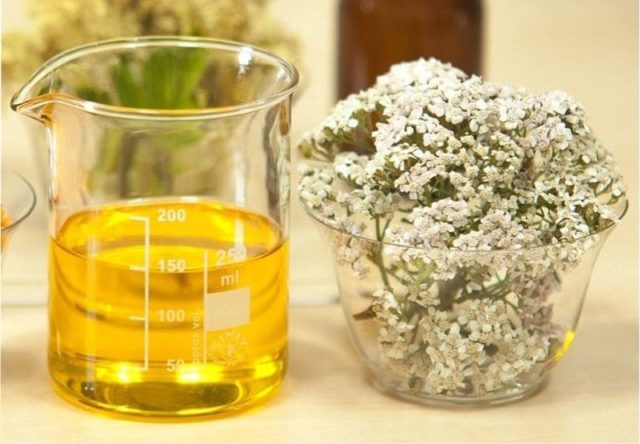
Decoction
A decoction of yarrow ptarmik has good medicinal properties. It is recommended to take it for constipation and for weight loss, for toothaches and colds, for inflammatory ailments. A healing agent is prepared according to the following algorithm:
- the dry roots of the sneezer are crushed in a volume of 5 g;
- useful raw materials are poured in 200 ml of hot water;
- heat on low heat for half an hour;
- removed from the stove and cooled under the lid for another hour.
The strained broth is taken in a large spoon up to three times a day. You can also use the product for gargling with sore throat and cough. Warm broth is allowed to be added to baths for rheumatism and muscle pain, it will contribute to relaxation and relieve discomfort.
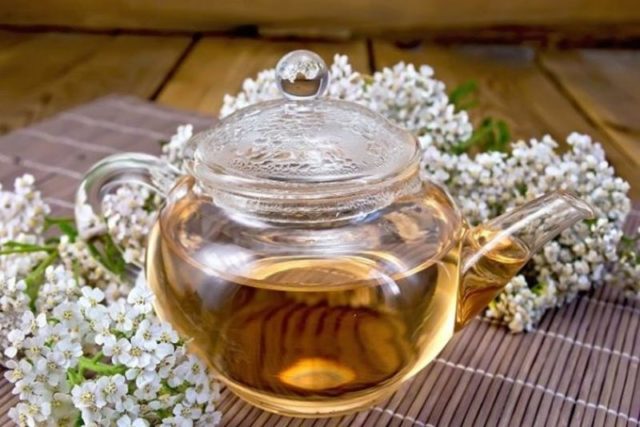
Powder
The common sneezer is used medicinally in powder form. The dried leaves of the plant are ground with a mortar to a state of fine dust. For a headache, you can simply inhale the powder alternately with each nostril 1-2 times in a row.
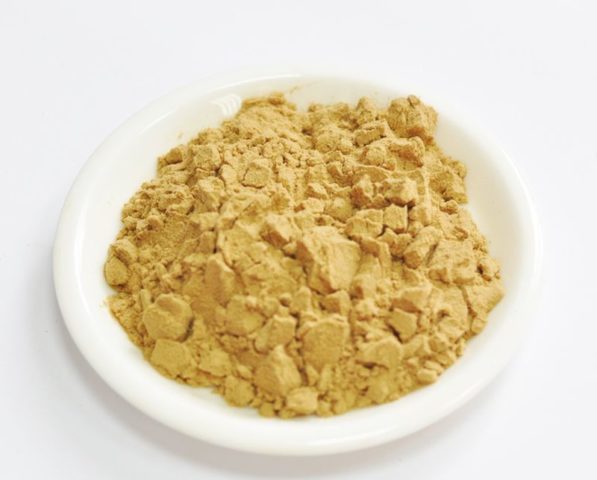
Application in traditional medicine
The valuable properties of the sneezer make it possible to cope with the symptoms of acute and chronic diseases. Traditional medicine offers several recipes indicating the safe dosages of the plant.
With a stomach ulcer
The common sneezer soothes irritated mucous membranes, relieves inflammation and normalizes the digestive process. For chronic peptic ulcer disease, the following infusion can be used:
- two small tablespoons of dried herbs are poured into a glass of boiling water;
- leave closed for three hours to infuse;
- passed through a layer of folded gauze.
It is necessary to take the drug 50 ml twice a day on an empty stomach. Treatment is carried out for a month.
With stomatitis and sore throat
The anti-inflammatory properties of the sneezer are beneficial for throat and gum disease. For medicinal purposes, an infusion is prepared according to the following recipe:
- a large spoonful of crushed dry leaves is poured with 250 ml of boiling water;
- the container is properly wrapped and left to infuse for an hour;
- passed through cheesecloth for filtration.
The infusion is used to rinse the mouth and throat in a warm form. The procedure can be carried out up to five times a day until the condition improves.
For muscle and joint pain
The common sneezer relieves joint inflammation, soothes muscle pain and restores healthy limb mobility. The following decoction is prepared for treatment:
- four large spoons of dry grass pour 1 liter of boiling water;
- simmer on the stove over low heat for about 20 minutes;
- slightly cool and filter through cheesecloth.
Warm broth can be added to medicinal baths - it is recommended to take them for at least 20 minutes. Also, a healing agent is used for compresses - a clean cloth is moistened in the preparation and applied to the diseased area for half an hour.
For toothache
The common sneezer has strong analgesic properties and helps with dental diseases. The rinse is prepared according to the following recipe:
- the dried root of the plant is crushed in the volume of a small spoon;
- pour 250 ml of hot water;
- kept closed for about an hour;
- filtered through folded gauze.
The finished infusion is used for rinsing several times a day.
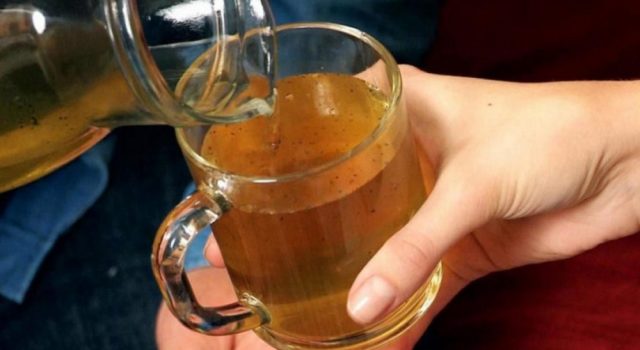
With uterine bleeding
The hemostatic properties of the sneezer are beneficial for gynecological ailments in women. Traditional medicine offers the following recipe:
- a dry plant is crushed in the volume of two large spoons;
- pour raw materials with a glass of hot water;
- leave closed for three hours.
After the expiration date, the agent is filtered. It is necessary to take it 50 ml twice a day - in the morning and in the evening.
With conjunctivitis
The healing properties of the common sneezer help to cope with inflammation in conjunctivitis. The drug is prepared according to the following algorithm:
- two small spoons of fresh or dried herbs are thoroughly chopped;
- brew with a glass of boiling water and insist for three hours;
- pass the finished product through cheesecloth.
In a warm infusion, moisten a clean cotton pad and apply to the eyes for 15 minutes. With severe inflammation, the procedure is carried out several times a day with an interval of 1-2 hours.
For skin itching and allergies
An ordinary sneezer relieves discomfort in case of skin diseases and allergic rashes. Traditional medicine recommends such a remedy for use:
- 5 g of dry grass is crushed and poured into 300 ml of boiling water;
- leave the medicine covered for 8-10 hours;
- passed through cheesecloth for filtration.
It is necessary to take the infusion inside three times a day, 20 ml each.

To cleanse the body of toxins
The sneezer herb helps to cleanse the blood, remove toxins from the tissues and improve overall well-being. For medicinal purposes, the following decoction is made:
- 1 liter of water is poured with 60 g of dry stems and leaves of the plant;
- for half an hour, boil over low heat;
- insist to cool under the lid and dilute with clean water to the initial volume.
You need to take the broth three times a day, 100 ml. They drink the healing remedy in courses of two weeks, while after the first of them they take a break for four days.
Contraindications to the use of sneeze herbs
The common sneezer herb is generally considered safe and rarely causes side effects. But in some conditions, it is not recommended to use it. It is necessary to refuse infusions and decoctions:
- with a tendency to blood thickening;
- with varicose veins and thrombophlebitis;
- during pregnancy and lactation;
- with individual allergies.
When treating an ordinary sneezer, the recommended dosages must be observed. Uncontrolled use of the herb can cause nausea, vomiting and diarrhea, as well as rashes and increased sensitivity of the skin to ultraviolet light.
Collection and procurement
Harvesting of leaves and stems of medicinal sneezer is carried out during the flowering period in early summer. The roots of the plant must be dug out in late autumn or early spring immediately after the snow melts. The collected raw materials are dried in the fresh air or in a warm room.
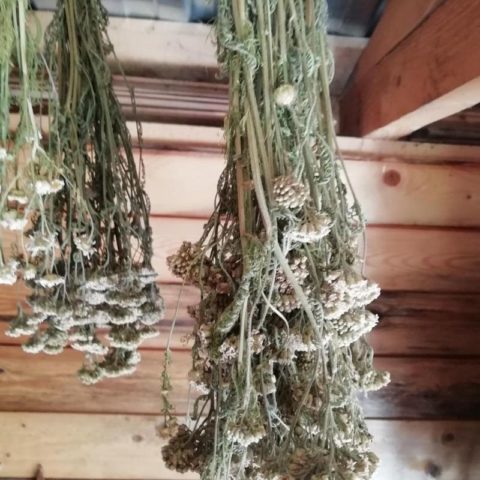
You need to store an ordinary sneezer in paper bags or glass containers in a dark cabinet. The grass retains its valuable properties for about a year, so it is recommended to carry out a new harvest every season.
Conclusion
The medicinal properties of sneeze herb and contraindications are combined with each other. When consumed in moderation, according to the rules, yarrow ptarmica is quite safe and brings great benefits to the body. It is used to treat inflammation and improve digestive processes.

